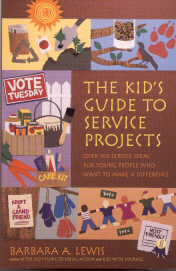
Title: The Kid's Guide to Service Projects
Author: Barbra A. Lewis
Ages: 9-12
Buy It Here:
Amazon
Summary: The Kid’s Guide to Service Projects is filled with ideas and service projects for subjects ranging from politics and government to the environment. The pages are filled with in-depth procedures and organizational tips for anything from a small class project to a large-scale community event. The Kids Guide to Service Projects is separated into sections based on the topic, and under each topic, contains multiple different ideas to make a change ranging from awareness campaigns to fundraising. The book empowers readers to become active in their communities and emphasizes that young children have a voice too, and can make a difference in the world.
Social Justice Element 6: The Kid’s Guide to Service Projects is an excellent source for students to gather ideas of how to make a change in the world. With Taking Social Action being the final stage of the Six Elements of Social Justice, students have already learned of current issues and this book is a perfect finisher to connect social issues and solutions together for students. The book holds 15 different topics including senior citizens, hunger, homeless people, the environment, and many more with helpful hints and great ideas to make a difference with these issues. Though the ideas provided are very useful and well thought out, students and teachers can alter them to better fit certain circumstances or situations.
How I’d Use It: This book can be used for so many different projects and lesson plans. With its 15 different topics, it is sure to cover some aspect of what students wish to make a change in, but if indeed it does not have a specific topic students are interested in, the book gives so many ideas that can easily be altered or mixed to integrate a different topic of interest. In closure, I would introduce a new issue to my students and have them research and learn more about this topic, and use this book as a wrap up to take their knowledge to the streets and make change.
Resources:
No comments:
Post a Comment